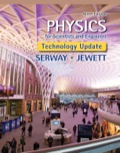
Concept explainers
The oldest artificial satellite still in orbit is Vanguard I, launched March 3, 1958. It mass is 1.60 kg. Neglecting atmospheric drag, the satellite would still be in its initial orbit, with a minimum distance from the center of Earth of 7.02 Mm and a speed at this perigee point of 8.23 km/s. For this orbit, find (a) the total energy of the satellite–Earth system and (b) the magnitude of the
(a)
The total energy of the satellite earth system.
Answer to Problem 13.79CP
The total energy of the satellite earth system is
Explanation of Solution
Given info: Mass of the satellite is
Write the expression for total energy of the satellite earth system.
Here,
Substitute
Conclusion:
Therefore, the total energy of the satellite earth system is
(b)
The magnitude of angular momentum of the satellite.
Answer to Problem 13.79CP
The magnitude of angular momentum of the satellite is
Explanation of Solution
Given info: Mass of the satellite is
Write the expression for angular momentum.
Here,
Substitute
Conclusion:
Therefore, the magnitude of angular momentum of the satellite is
(c)
The satellite’s speed and it’s distanced from the centre of the earth at apogee.
Answer to Problem 13.79CP
The satellite’s speed is
Explanation of Solution
Given info: Mass of the satellite is
Write the expression for total energy at apogee.
Here,
Write the expression for angular momentum at apogee.
Rearrange the expression for distanced from the centre of the earth at apogee.

Substitute
Rearrange the above equation to get a quadratic equation of
Substitute
Find the smaller roots of the above equation.
Substitute
Conclusion:
Therefore, the satellite’s speed is
(d)
The semi major axis of its orbit.
Answer to Problem 13.79CP
The semi major axis of its orbit is
Explanation of Solution
Given info: Mass of the satellite is
Write the expression for length of major axis.
Substitute
Conclusion:
Therefore, the semi major axis of its orbit is
(e)
The period of the satellite.
Answer to Problem 13.79CP
The period of the satellite is
Explanation of Solution
Given info: Mass of the satellite is
Write the expression for time period.
Substitute
Conclusion:
Therefore, the period of the satellite is
Want to see more full solutions like this?
Chapter 13 Solutions
EBK PHYSICS FOR SCIENTISTS AND ENGINEER
- In general it is best to conceptualize vectors as arrows in space, and then to make calculations with them using their components. (You must first specify a coordinate system in order to find the components of each arrow.) This problem gives you some practice with the components. Let vectors A = (1,0, -3), B = (-2, 5, 1), and C = (3,1,1). Calculate the following, and express your answers as ordered triplets of values separated by commas.arrow_forwardIn general it is best to conceptualize vectors as arrows in space, and then to make calculations with them using their components. (You must first specify a coordinate system in order to find the components of each arrow.) This problem gives you some practice with the components. Let vectors A = (1,0, −3), B = (-2, 5, 1), and C = (3,1,1). Calculate the following, and express your answers as ordered triplets of values separated by commas.arrow_forwardOnly Part C.) is necessaryarrow_forward
- Only Part B.) is necessaryarrow_forwardA (3.60 m) 30.0°- 70.0° x B (2.40 m)arrow_forwardIn general it is best to conceptualize vectors as arrows in space, and then to make calculations with them using their components. (You must first specify a coordinate system in order to find the components of each arrow.) This problem gives you some practice with the components. Let vectors A = (1,0, -3), B = (-2, 5, 1), and C = (3,1,1). Calculate the following, and express your answers as ordered triplets of values separated by commas.arrow_forward
- fine the magnitude of the vector product express in sq meters what direction is the vector product in -z or +zarrow_forward4) Three point charges of magnitude Q1 = +2.0 μC, Q2 = +3.0 μС, Q3 = = +4.0 μС are located at the corners of a triangle as shown in the figure below. Assume d = 20 cm. (a) Find the resultant force vector acting on Q3. (b) Find the magnitude and direction of the force. d Q3 60° d Q1 60° 60° Q2 darrow_forwardThree point charges of magnitudes Q₁ = +6.0 μС, Q₂ = −7.0 μС, Qз = −13.0 μC are placed on the x-axis at x = 0 cm, x = 40 cm, and x = 120 cm, respectively. What is the force on the Q3 due to the other two charges?arrow_forward
 Principles of Physics: A Calculus-Based TextPhysicsISBN:9781133104261Author:Raymond A. Serway, John W. JewettPublisher:Cengage Learning
Principles of Physics: A Calculus-Based TextPhysicsISBN:9781133104261Author:Raymond A. Serway, John W. JewettPublisher:Cengage Learning College PhysicsPhysicsISBN:9781285737027Author:Raymond A. Serway, Chris VuillePublisher:Cengage Learning
College PhysicsPhysicsISBN:9781285737027Author:Raymond A. Serway, Chris VuillePublisher:Cengage Learning University Physics Volume 1PhysicsISBN:9781938168277Author:William Moebs, Samuel J. Ling, Jeff SannyPublisher:OpenStax - Rice University
University Physics Volume 1PhysicsISBN:9781938168277Author:William Moebs, Samuel J. Ling, Jeff SannyPublisher:OpenStax - Rice University Physics for Scientists and Engineers: Foundations...PhysicsISBN:9781133939146Author:Katz, Debora M.Publisher:Cengage Learning
Physics for Scientists and Engineers: Foundations...PhysicsISBN:9781133939146Author:Katz, Debora M.Publisher:Cengage Learning Classical Dynamics of Particles and SystemsPhysicsISBN:9780534408961Author:Stephen T. Thornton, Jerry B. MarionPublisher:Cengage Learning
Classical Dynamics of Particles and SystemsPhysicsISBN:9780534408961Author:Stephen T. Thornton, Jerry B. MarionPublisher:Cengage Learning Modern PhysicsPhysicsISBN:9781111794378Author:Raymond A. Serway, Clement J. Moses, Curt A. MoyerPublisher:Cengage Learning
Modern PhysicsPhysicsISBN:9781111794378Author:Raymond A. Serway, Clement J. Moses, Curt A. MoyerPublisher:Cengage Learning





